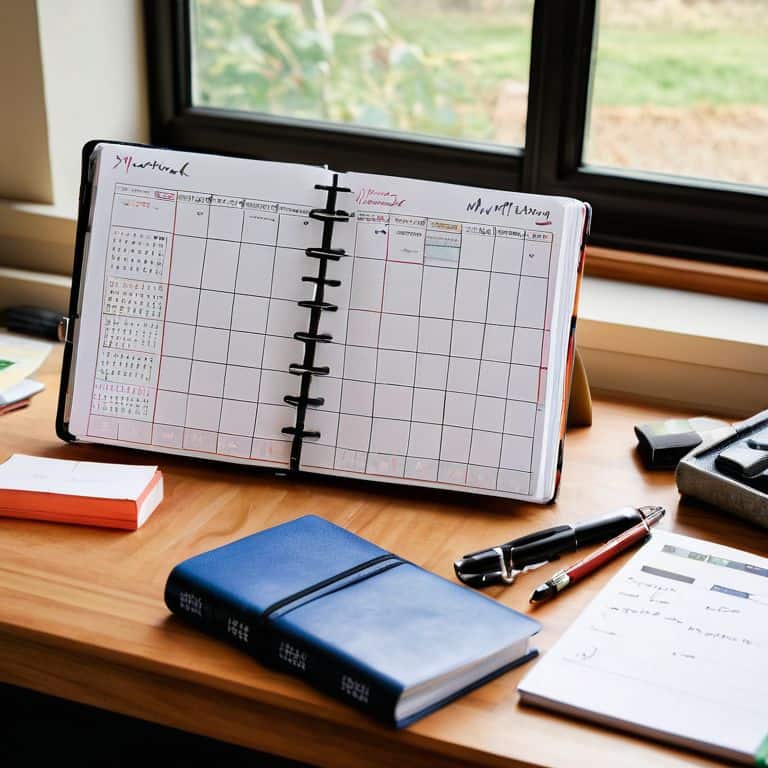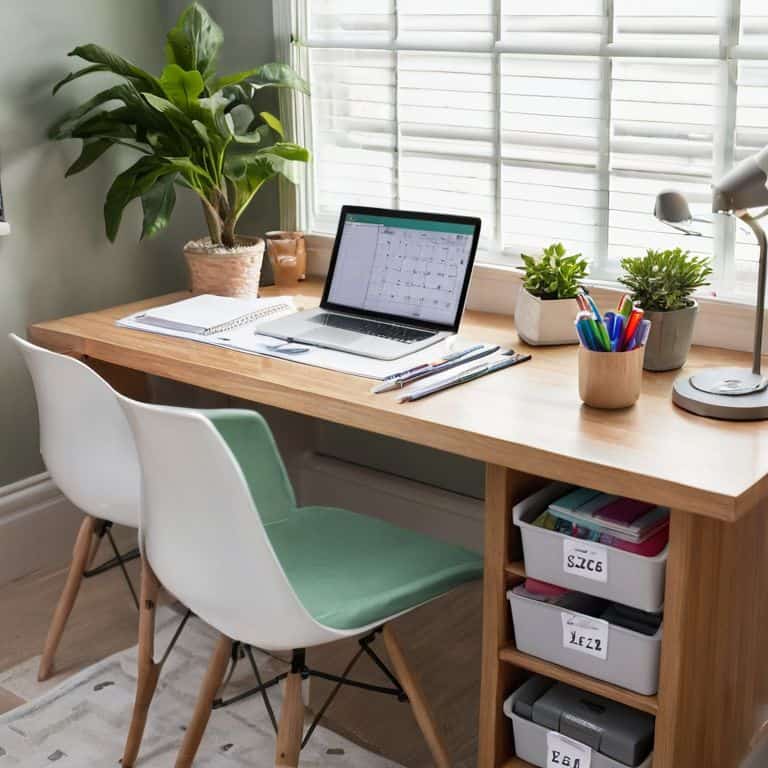I still remember the day I thought I’d mastered how to use time blocking effectively – only to realize I was just spinning my wheels. I had color-coded calendars, meticulously scheduled breaks, and a rigid plan that left no room for spontaneity. But despite my best efforts, I felt like I was drowning in a sea of tasks, with no lifeline in sight. It wasn’t until I took a step back and reassessed my approach that I discovered the truth: time blocking isn’t about cramming more into your schedule, but about creating space for what truly matters.
So, if you’re tired of feeling like you’re stuck in a never-ending cycle of busywork, you’re in the right place. In this article, I’ll share my hard-won lessons on how to use time blocking effectively, without the fluff or clichés. You’ll learn how to prioritize your tasks, avoid common pitfalls, and create a schedule that actually works for you, not against you. By the end of this guide, you’ll have a clear, actionable plan to reclaim your time and your sanity – and I’m excited to share it with you, one practical tip at a time.
Table of Contents
Guide Overview: What You'll Need

Total Time: 1 hour 30 minutes
Estimated Cost: $0 – $10
Difficulty Level: Easy
Tools Required
- Calendar or Planner (physical or digital)
- Pencil or Pen (for writing)
- Eraser (for correcting mistakes)
Supplies & Materials
- Sticky Notes (for reminders)
- Highlighters (for color-coding)
- Ruler (for drawing schedules)
- Paper (for printing schedules)
- Timer (optional)
Step-by-Step Instructions
- 1. First, let’s get real about what time blocking is and how it can change your life – it’s essentially scheduling your tasks into fixed, uninterrupted blocks of time, allowing you to focus on one thing at a time without multitasking, which is a major productivity killer. To start, grab your calendar, whether it’s digital or physical, and begin by blocking out your non-negotiables, like sleep, meals, and exercise, to create a foundation for your schedule.
- 2. Next, identify your most important tasks for the week, and I mean the ones that will truly move the needle in your business or personal life – these should be your top priorities. Don’t worry too much about categorizing them as work or personal; just focus on what needs to get done. Write each task down on a sticky note or in a notes app, and then start grouping similar tasks together, like all your writing tasks or all your client calls.
- 3. Now it’s time to assign time slots to each of these task groups – be realistic about how long each task will take, and don’t be afraid to leave some buffer room for unexpected things that come up. A good rule of thumb is to overestimate the time you think you’ll need by about 25%, just to be safe. For example, if you think a task will take 2 hours, block out 2.5 hours to account for any unexpected interruptions or distractions.
- 4. Once you have your tasks scheduled, it’s essential to protect your time blocks from others and yourself – this means communicating your schedule to your team, family, or friends, and setting clear boundaries around your work hours. It also means avoiding the temptation to check email or social media during your focused work time, as these can be major distractions that derail your productivity.
- 5. To take your time blocking to the next level, consider implementing a “batching” system, where you group similar tasks together and complete them in one session – for example, checking and responding to all your emails at once, rather than constantly throughout the day. This can help you stay in a state of flow and reduce the time and energy wasted on switching between tasks.
- 6. As you start using time blocking, it’s crucial to review and adjust your schedule regularly – this means taking some time each week to reflect on what’s working and what’s not, and making adjustments as needed. Ask yourself questions like, “Am I leaving enough time for focused work?” or “Are there any tasks that can be delegated or automated?” and make changes to optimize your schedule for maximum productivity.
- 7. Finally, don’t forget to schedule downtime into your calendar, too – this means blocking out time for rest, relaxation, and rejuvenation, whether that’s reading a book, taking a walk, or simply enjoying a cup of coffee in peace. Remember, time blocking is not just about getting more done; it’s also about creating space for the things that bring you joy and help you recharge.
Master Time Blocking

To take your time blocking to the next level, it’s essential to master the art of effective task prioritization techniques. This means being ruthless about what makes it onto your schedule and what doesn’t. I like to use the Eisenhower Matrix to categorize my tasks into urgent vs. important, and then focus on the most critical ones first. By doing so, you’ll be able to tackle the tasks that have the greatest impact on your goals, and leave the non-essential ones behind.
Another crucial aspect of time blocking is avoiding distractions during focused work. This means eliminating any potential interruptions, such as turning off notifications or finding a quiet workspace. I also recommend using scheduling tools for deep work, like website blockers or apps that help you stay on track. By minimizing distractions, you’ll be able to fully immerse yourself in the task at hand and make the most of your time.
By implementing these strategies, you’ll be well on your way to achieving time estimation for task management that actually works. Remember, the key is to be flexible and adapt your time blocking schedule as needed. Don’t be too hard on yourself if you don’t get it right immediately – with practice, you’ll become a pro at calendar organization strategies and be able to manage your time like a boss.
Avoid Distractions
When you’re in deep work mode, it’s crucial to eliminate any distractions that can derail your focus. For me, that means turning off notifications on my phone and finding a quiet spot to work. I’ve also learned to avoid multitasking – it’s a productivity killer. Instead, I dedicate specific time blocks to checking emails or social media, so I can stay focused on the task at hand. By minimizing distractions, you can stay in flow and make the most of your time blocks. Whether it’s finding a co-working space, using website blockers, or simply putting your phone on silent, find what works for you and stick to it.
Schedule Deep Work
To truly master time blocking, you need to schedule deep work sessions. This means dedicating a solid chunk of time to focused, uninterrupted work. I’m talking at least 90 minutes without checking email or social media. For me, this usually happens in the morning, after a refreshing run and a great cup of coffee. By prioritizing deep work, you’ll be amazed at how much you can accomplish in a shorter amount of time.
When scheduling deep work, consider your energy levels and attention span. If you’re a morning person like me, block out the morning for intense focus. If you’re more of a night owl, schedule your deep work sessions for later in the day. The key is to find a rhythm that works for you and stick to it, allowing you to make the most of your time and energy.
Time Blocking Like a Pro: 5 Essential Tips
- Set clear goals for each block of time to maintain focus and direction
- Learn to say no to non-essential tasks that can derail your schedule
- Use a ‘buffer zone’ between blocks for transition and relaxation
- Prioritize self-care activities, like exercise or meditation, in your time blocks
- Review and adjust your time blocking schedule regularly to ensure it’s working for you, not against you
Time Blocking Takeaways
Ditch the notion that you need to be constantly available and adopt time blocking to reclaim your weekends and sanity
Schedule deep work sessions to tackle complex tasks, eliminating distractions and boosting productivity
Master the art of avoiding distractions during your time blocks, and watch your creativity and focus soar to new heights
Time Blocking Wisdom
Time blocking isn’t just about scheduling your tasks, it’s about scheduling your sanity – it’s the difference between living a life that’s controlled by your to-do list, and one that’s guided by your goals and values.
Jenna Sullivan
Taking Back Control of Your Time

So, there you have it – a crash course in using time blocking to revolutionize your productivity. From scheduling deep work sessions to avoiding distractions, we’ve covered the essential steps to help you reclaim your time and energy. Remember, mastering time blocking is all about finding a rhythm that works for you and sticking to it. Don’t be too hard on yourself if you slip up – simply acknowledge the setback and get back on track.
As you embark on this journey to optimize your schedule, keep in mind that consistency is key. By committing to your time blocking plan, you’ll be amazed at how much more you can accomplish in less time, leaving you with guilt-free weekends to pursue your passions. So, go ahead and take a deep breath – you’re one step closer to achieving that elusive work-life balance, and I’m rooting for you every step of the way!
Frequently Asked Questions
How do I determine the optimal block size for my tasks and schedule?
Honestly, determining the optimal block size is all about trial and error – I recommend starting with 90-minute blocks for focused work and adjusting from there based on your energy levels and task complexity.
What if I need to make changes to my time-blocked schedule, how can I adjust without losing momentum?
No worries, life happens! When you need to make changes, simply reassess your priorities, adjust the blocks as needed, and communicate the updates to anyone affected. Don’t overthink it – just pivot and keep moving forward. Remember, time blocking is a flexible tool, not a rigid rulebook. Now, go grab a fresh cup of coffee and get back to crushing your goals!
Can time blocking be used for personal tasks and activities outside of work, such as exercise or family time?
Absolutely, time blocking isn’t just for work – I use it to schedule my long runs, cooking experiments, and even date nights. By prioritizing personal activities, you can achieve a better work-life balance and make time for the things that bring you joy and relaxation. Give it a try and see how it can transform your weekends and free time!
